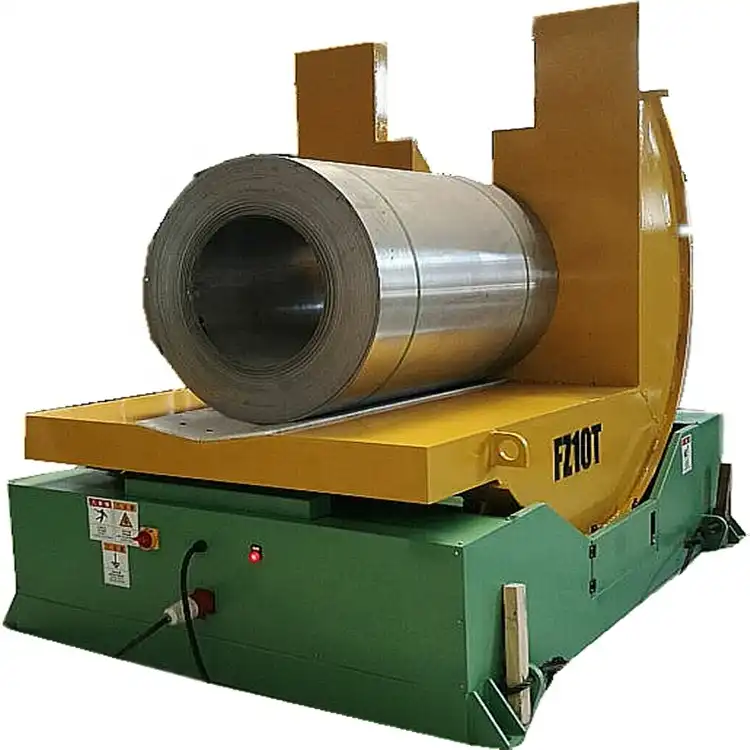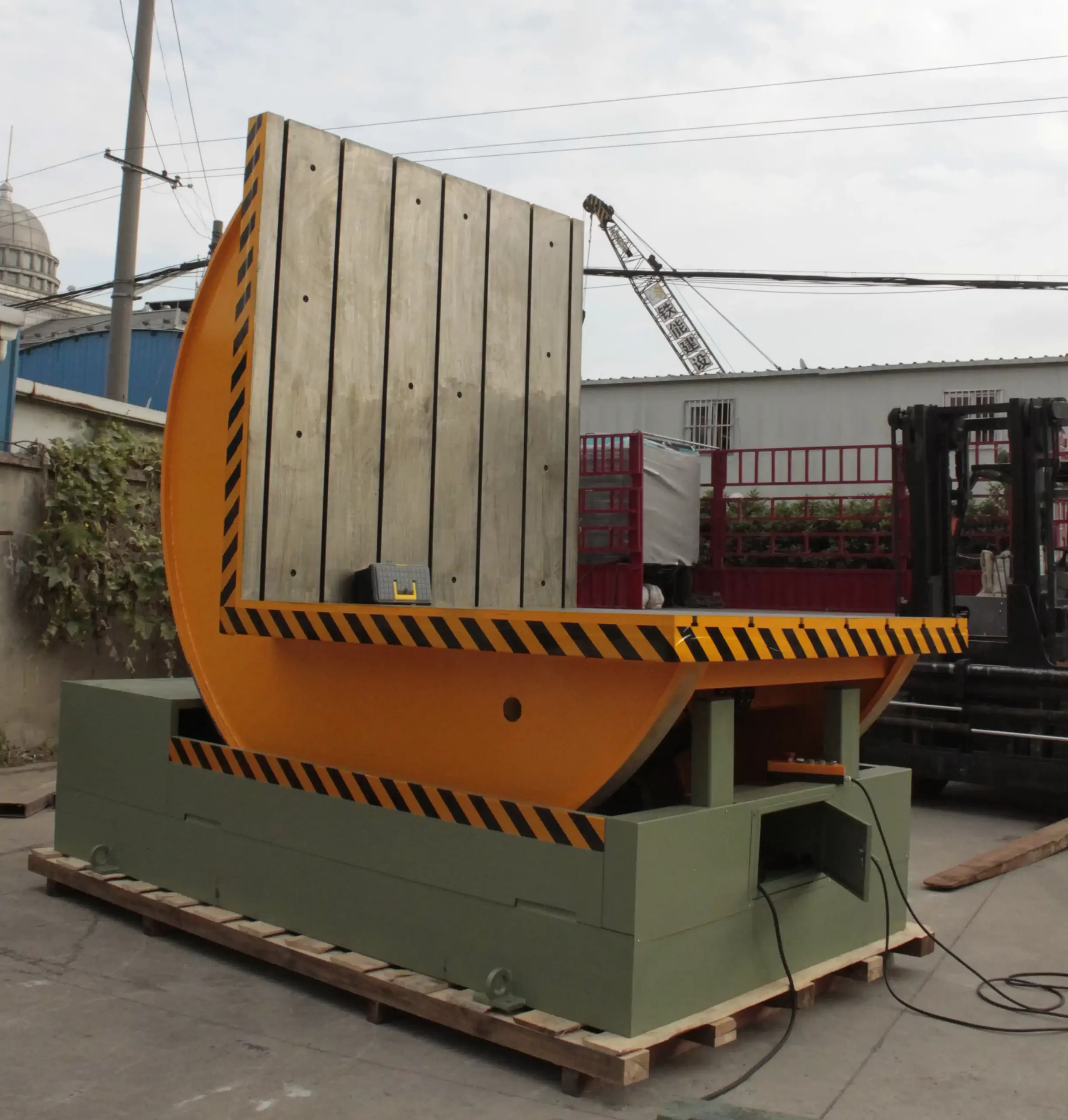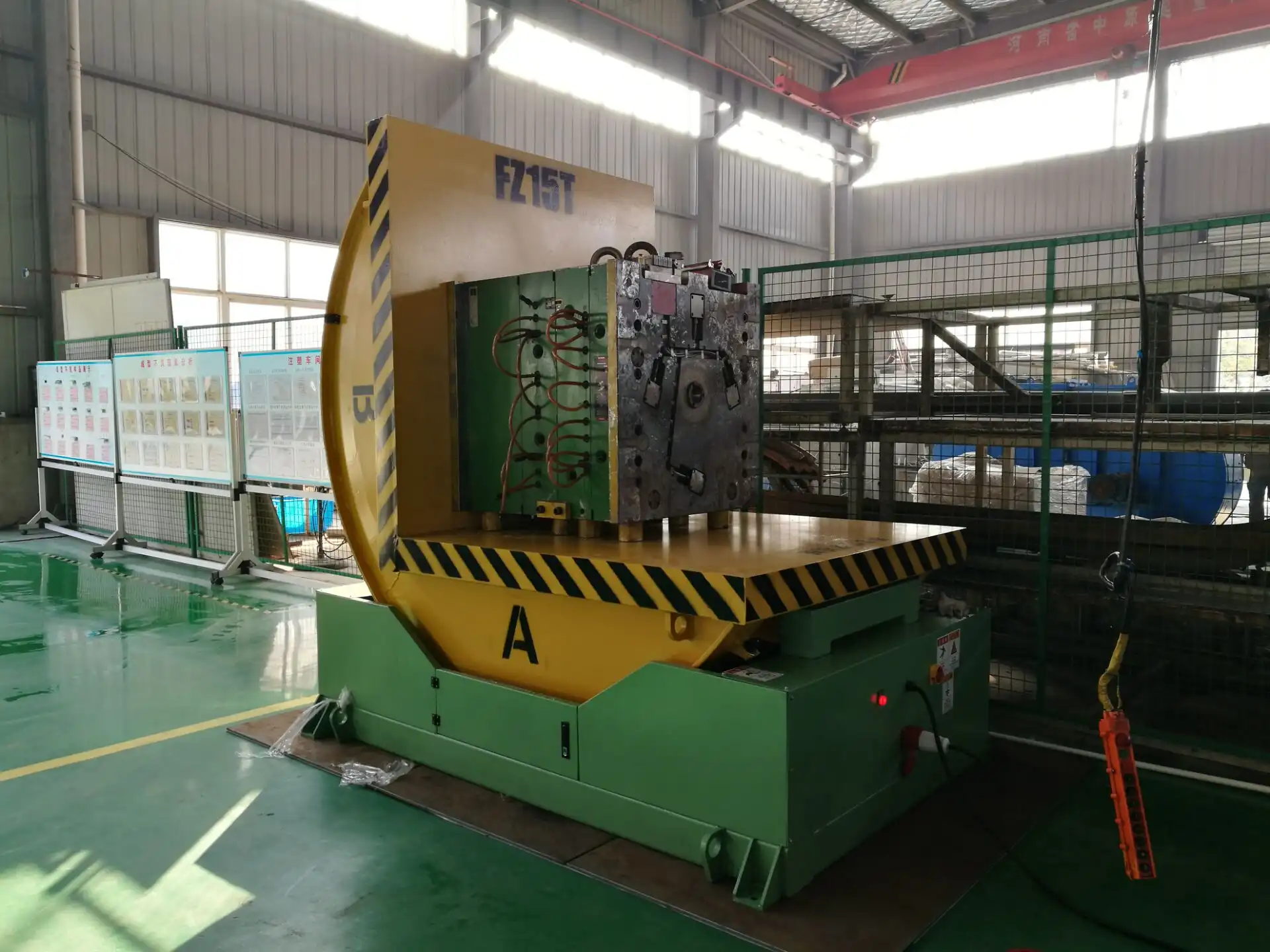As an engineer who has spent his entire career on the factory floor, I have seen firsthand how small inefficiencies can create huge problems. I have walked through countless steel plants, and I often see the same thing: strong, hardworking teams using sheer force for tasks that technology could handle effortlessly. In a modern Brazilian steel plant, watching workers manually tilt heavy, hot molds is one of those scenes. It feels familiar, even traditional. But it's a process loaded with hidden costs, risks, and bottlenecks that directly impact your bottom line. You might be losing money every single day, not because of a major breakdown, but because of a process you've accepted as "the way things are done."
Yes, manual mold tilting is almost certainly costing your Brazilian plant significant time and labor. This outdated method directly contributes to higher operational costs through production bottlenecks, increased risk of worker injury, inconsistent handling that can damage molds and other equipment, and the inefficient use of skilled labor that could be performing more valuable tasks.

I understand that as a CEO and owner, you need more than just a simple "yes" or "no." You need to see the numbers, understand the return on investment, and know how a change like this fits into your larger strategic goals. You are managing a massive operation, with goals to increase uptime to 95% and reduce operating costs. You aren't just buying a piece of equipment; you are investing in a solution that must deliver measurable results. Let's break down exactly where the costs of manual tilting are hiding and how automation provides a clear path to a more efficient, profitable, and safer plant.
How Does Manual Handling Really Impact Your Uptime and Maintenance Costs?
I often talk to plant managers who are frustrated with unscheduled downtime. They point to a major piece of equipment that failed, like a crane or a conveyor. The problem, they believe, is that the equipment is simply old. But when we dig deeper, we often find that the root cause isn't just age. It's the accumulated stress from years of inconsistent, manual handling. A dropped mold, a rough placement, an unbalanced lift—these events send shockwaves through your machinery. They create micro-stresses that you don't see, until they result in a sudden, expensive failure. The manual process itself is actively shortening the life of your other capital equipment.
Automated handling directly addresses this by introducing consistency and control. A mechanical tilter performs the same smooth, precise movement every single time. It eliminates the shocks and impacts that wear down your cranes, bearings, and transport systems. This not only reduces the frequency of unexpected breakdowns but also protects your downstream equipment, extending its operational life. It’s a solution that stops the cycle of reactive repairs and allows you to build a more stable, predictable production environment.

The True Cost of Inconsistent Operations
When you rely on manual labor for heavy tasks like mold tilting, you are introducing a variable that is impossible to control. The way a mold is handled at the beginning of a shift by a fresh team is different from how it's handled at the end of a long day. This inconsistency has a direct impact on your machinery. An overhead crane, for example, is designed for smooth, balanced loads. When a mold is manually slung and lifted, it can swing or be positioned off-center. This creates uneven stress on the crane's motors, cables, and structural components. It's like driving your car by constantly slamming on the gas and then the brakes, instead of accelerating smoothly. It works, but it causes massive wear and tear over time.
This same principle applies to your molds and any equipment they interact with. A hard landing on a conveyor or transfer car can cause damage that is not immediately visible. Over time, these small impacts lead to premature component failure. Your maintenance team ends up in a constant state of fire-fighting, replacing parts that should have lasted much longer. This directly fights against your goal of achieving 95% equipment uptime. You are trapped in a reactive maintenance cycle, where your costs are unpredictable and your production schedule is always at risk.
Moving from Reactive to Proactive Maintenance
Automated systems transform your maintenance strategy. Because an automated tilter operates within precise, pre-defined parameters, the stress on your equipment becomes predictable. The movements are always smooth and controlled. This stability allows you to shift from a reactive "fix it when it breaks" model to a proactive, data-driven one.
An automated system can track its own usage, counting every cycle. This data is invaluable. You know exactly how many times a tilter has operated, allowing you to schedule maintenance based on actual usage, not just a generic time interval. This is the foundation of predictive maintenance. It reduces the chance of unexpected failure and ensures that maintenance is performed only when necessary, saving both time and money. By removing the unpredictable variable of manual handling, you create a more stable system where you can accurately forecast maintenance needs, manage spare parts inventory efficiently, and keep your production lines running smoothly. This is a critical step in achieving the operational stability needed to reach your uptime and cost-reduction targets.
| Feature | Manual Mold Tilting | Automated Mold Tilting |
|---|---|---|
| Equipment Stress | High and unpredictable; shock loads are common. | Low and consistent; smooth, controlled motion. |
| Component Wear | Accelerated wear on cranes, slings, molds. | Reduced wear and tear; longer component life. |
| Failure Mode | Sudden, catastrophic failures are more likely. | Predictable wear; enables proactive replacement. |
| Maintenance Type | Primarily reactive (emergency repairs). | Primarily predictive and planned. |
| Uptime Impact | Frequent unscheduled downtime. | Maximized uptime and production stability. |
Can Automated Tilting Directly Reduce Your Operational Costs and Energy Consumption?
Every business leader, especially in a capital-intensive industry like steel, is focused on operational costs. You have a target to reduce overall costs by 8% and energy consumption by 10%. These are significant goals that require more than small tweaks. You need to find areas of fundamental inefficiency. Manual material handling is one of the most significant. Think about the process: it requires multiple workers to be present, it takes time to coordinate, and it often keeps expensive machinery like overhead cranes running longer than necessary, burning fuel or electricity with every minute of idle time.
An automated tilter attacks these costs from multiple angles. First, it reduces direct labor costs. A task that might require two or three people can be managed by a single operator overseeing an automated process. This frees up your skilled workers to focus on tasks that add more value, like quality control or machine supervision. Second, it optimizes energy use. Automated cycles are fast and efficient. The crane is used for the exact time needed to lift and move the mold, not a second longer. There is no waiting for manual rigging. When you multiply these small time savings over thousands of cycles a year, the reduction in energy consumption becomes substantial, helping you move closer to that 10% goal.

A Practical Breakdown of Cost Savings
Let's look at the numbers in a more structured way. The most obvious saving is in labor. If you are running three shifts, and a manual tilting operation requires two dedicated workers per shift, that's six employees whose time is spent on a repetitive, low-skill, high-risk task. By automating this process, you could potentially reassign all six of those workers to other areas of the plant where their skills can be better used. This is not about eliminating jobs; it's about optimizing your workforce. In my experience, successful plants are the ones that use their people for their intelligence, not just their physical strength. This move alone can represent a significant reduction in your operational budget.
Next, consider the cost of inefficiency. Manual processes are inherently slower. The time spent attaching slings, communicating between the crane operator and the ground crew, and carefully maneuvering the load all adds up. An automated tilter can complete a cycle in a fraction of that time. Let’s say you save just 90 seconds per cycle. If you perform this operation 200 times a day, that's 50 hours of saved operational time every single day. That is time that your production line is moving, not waiting. This directly boosts your output without any other changes. It also reduces wear and tear, as discussed before, which lowers your maintenance and spare parts budget. These are tangible, measurable savings that contribute directly to your 8% overall cost reduction goal.
The Energy Efficiency Equation
Energy costs are volatile and a major concern for any steel producer. Your goal to reduce unit energy consumption by 10% is ambitious but achievable. Automated material handling is a key part of the solution. The biggest energy consumer in the tilting process is often the overhead crane. When a crane is waiting for a manual crew to rig a mold, its motor is often idling, consuming power. During the slow, careful process of a manual lift, the crane operates for a longer duration.
An automated system changes this equation. The cycle is optimized for speed and efficiency. The interaction with the crane is programmed to be as short as possible. The tilter presents the mold for a quick, clean lift. The crane does its job and moves on. The reduction in the crane's operating time per cycle might seem small, but the cumulative effect is enormous. By cutting the crane's run time, you directly cut its energy consumption. This saving, combined with other energy initiatives like waste heat recovery, makes your 10% reduction target realistic. Automation turns an energy-inefficient process into a lean, optimized one, providing a clear and quantifiable return on investment.
| Cost Factor | Manual Mold Tilting | Automated Mold Tilting | Potential Impact on Goals |
|---|---|---|---|
| Direct Labor | Requires 2-3 workers per operation. | Requires 1 operator for supervision. | Contributes to 8% operating cost reduction. |
| Cycle Time | Slower due to rigging and coordination. | Faster, repeatable, optimized cycles. | Increases throughput and efficiency. |
| Energy Use | High; cranes idle and run for longer. | Lower; optimized crane use, no idle time. | Contributes to 10% energy consumption reduction. |
| Safety Costs | Higher risk of accidents, injuries, insurance claims. | Minimal risk, engineered safety features. | Reduces hidden costs and improves workforce morale. |
| Material Damage | Risk of damaging expensive molds. | Gentle, controlled handling prevents damage. | Lowers replacement and repair costs. |
How Does Automation Pave the Way for Your Digital Transformation?
Your goal to deploy MES, IoT sensors, and data analytics is not just about technology; it's about visibility. You want to see what is happening on your factory floor in real-time. But there is a fundamental problem: you cannot analyze what you do not measure. Manual processes are "black boxes." They don't generate data. You don't know exactly when a process started, when it ended, or if there were any deviations. This lack of data makes it impossible for your advanced digital systems to work effectively. Your digital transformation journey will stall if it's built on a foundation of manual, unrecorded activities.
This is where automation becomes the critical link. Automated equipment, like a modern tilter or a packing line, is designed to be a source of data. It is the bridge between the physical world of your factory and the digital world of your MES or ERP system. Every action the machine takes can be logged, timed, and recorded. It turns a black box process into a transparent data node. Investing in automation is not just about solving a physical handling problem; it's a foundational step that provides the clean, reliable data you need to make your entire digital strategy a success.

From Black Box to Data Source
Think about the data you get from a manual process. At best, a worker might write down a time on a piece of paper. This data is often inaccurate, inconsistent, and entered hours after the event. It is useless for real-time decision-making. Now, compare that to an automated tilter integrated with sensors. You get a precise timestamp for when a mold enters the station. You can verify its weight. You know the exact duration of the tilt cycle, down to the millisecond. You get a timestamp for when it leaves the station. The machine can even report its own status and log any errors or alerts automatically.
This is the raw material for your digital transformation. This stream of clean, consistent data can be fed directly into your Manufacturing Execution System (MES). Your production managers no longer have to guess where a particular mold is in the process; they can see it on a screen. They can identify bottlenecks not by walking the floor, but by looking at cycle time data. They can see which processes are running smoothly and which ones are causing delays. As an engineer who is passionate about data, I can tell you that this transition from no data to rich data is the single most important step in modernizing a plant's operations.
Integrating Automation into Your Plant's Digital Ecosystem
A modern automated machine is not a standalone island. It is designed to communicate. When we design a solution like a tilter or a complete coil packing line, we build it with connectivity in mind. It needs to speak the same language as your other systems. This means it can be integrated seamlessly with your plant-level control systems (PLCs) and your higher-level MES and ERP software. This integration is where the magic happens.
For example, the MES can send an order to the tilter to process a specific mold. The tilter performs the task and reports back to the MES that the task is complete. This creates a closed-loop system of command and confirmation. This data can then be used by the MES to automatically update production schedules, track inventory of work-in-progress, and provide managers with an accurate, up-to-the-minute view of the entire factory. This level of visibility and control is impossible with manual processes. It allows you to optimize production flow, reduce lead times, and make smarter, data-driven decisions. It is the realization of your goal for comprehensive production visualization.
| Data Point | Manual Process | Automated Process |
|---|---|---|
| Cycle Start/End | Unrecorded or manually logged with errors. | Automatically timestamped to the millisecond. |
| Cycle Duration | Variable and unknown. | Consistent and precisely measured. |
| Product ID | Requires manual scanning or visual check. | Can be integrated with barcode/RFID readers. |
| Error Logging | Relies on operator reporting. | Automatic fault codes generated and logged. |
| Machine Status | Unknown unless visually inspected. | Real-time status (running, idle, fault) sent to MES. |
| Data Integrity | Low, prone to human error. | High, reliable, and consistent. |
My Insights
Javier, when I read your profile, your journey from a team leader in a steel plant to the owner of a major mill resonated with me. I also started my career on the factory floor, learning the nuts and bolts of packing machinery. That experience taught me a valuable lesson: the biggest challenges in a factory are rarely solved by simply working harder. They are solved by working smarter. My journey allowed me to build my own company, and now, like you, I feel a responsibility to share what I've learned to help others in this industry succeed.
The question of manual versus automated mold tilting is not really about one machine. It is about an entire operational philosophy. It’s about the choice between accepting hidden costs and inefficiencies as "part of the business," or actively seeking them out and eliminating them with modern solutions. Your challenges—volatile energy costs, aging equipment, and market fluctuations—are pressures that every steel producer in the world is facing. The companies that will thrive are the ones that see these challenges not as problems, but as opportunities to innovate.
An investment in an automated tilter is a perfect example of this. It's a single investment that addresses multiple challenges at once. It protects your aging equipment from unnecessary stress. It directly reduces your labor and energy costs, giving you a buffer against market volatility. Most importantly, it generates the data that is essential for the digital transformation you are planning. It is not just a piece of hardware; it is a strategic tool. As an engineer and a factory owner, I believe the best investments are the ones that pay dividends across the entire operation. This is one of them. What we offer at SHJLPACK is more than a machine. It's a partnership. We provide a total solution because we understand that your success is tied to ours.

Conclusion
Upgrading from manual mold tilting is not just an equipment change. It is a strategic move towards a safer, more efficient, and data-driven future for your Brazilian plant.




